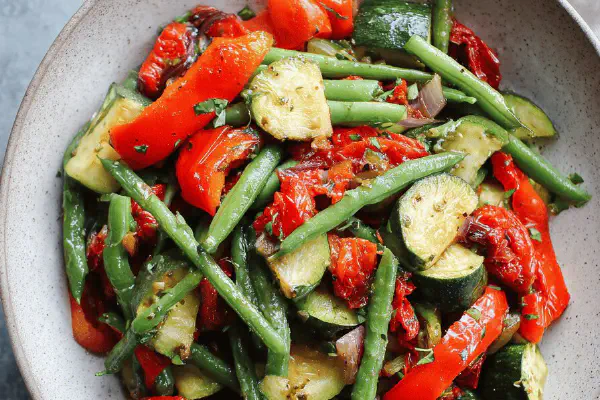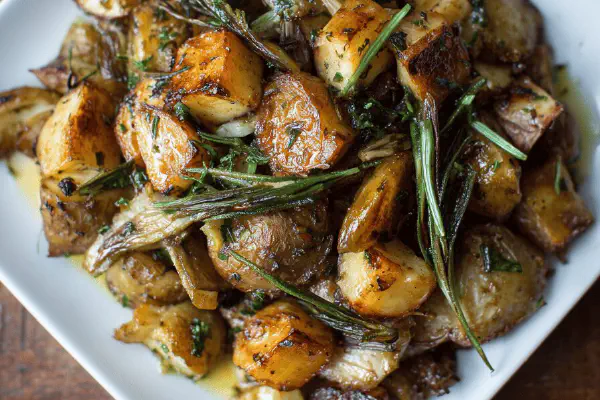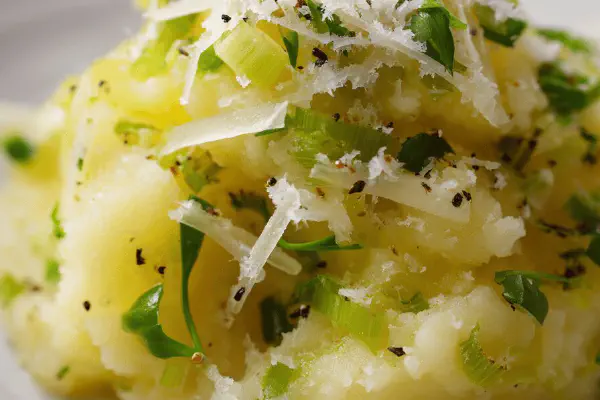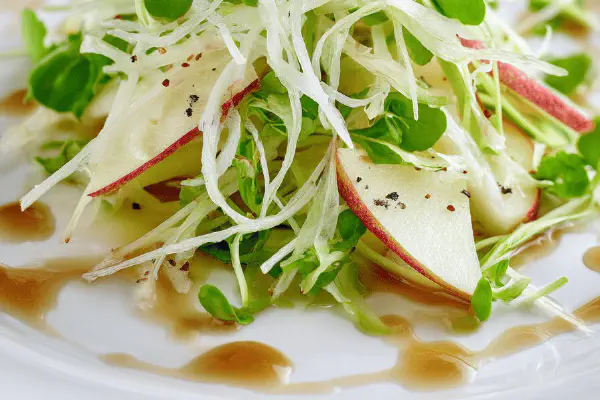Tender Veggies in Tomato Sauce

By Emma
Certified Culinary Professional
Ingredients
- 1 small zucchini, cut into cubes
- 1/4 cup olive oil
- 1 red bell pepper, seeded and cubed
- 1 medium onion, thinly sliced
- 2 garlic cloves, minced
- 1 can 540 ml fire-roasted diced tomatoes
- 1 cup green beans, trimmed and cut into 4 cm pieces
- Salt
- Freshly ground black pepper
About the ingredients
Method
- Heat half the olive oil over medium-high heat in a wide, heavy-bottomed skillet. Toss in zucchini cubes, stirring often, until golden brown and slightly softened—look for edges to crisp and slight shriveling to know they're done; about 7-8 minutes. Remove with tongs or slotted spoon; drain excess oil on paper towels. Set aside.
- Add remaining olive oil to skillet. Lower heat to medium. Throw in red bell pepper, sliced onion, and garlic. Stir often—onion becomes translucent and fragrant, bell pepper softens but keeps shape. Takes roughly 5-7 minutes. Use a wooden spoon to scrape any browned bits from zucchini step—they add depth.
- Pour in fire-roasted diced tomatoes with their juices. Stir well, scraping bottom to loosen caramelized bits. Bring to a steady simmer.
- Add green beans and roasted zucchini back to pan. Stir, cover immediately to trap steam. Reduce heat to medium-low. Let vegetables cook undisturbed for 18-20 minutes, stirring gently once or twice to prevent sticking. Watch for beans turning bright green and tender but not mushy. Nose picks up tomato acidity mingling with roasted pepper aroma.
- Uncover, season liberally with salt and freshly ground pepper to taste. Give a final stir. If sauce is too liquid, raise heat slightly and simmer uncovered 2-3 minutes to thicken up. Done when veggies yield easily to a fork but still hold form.
- Serve hot or warm. Optional squeeze of fresh lemon or sprinkle of chopped basil for brightness.
Cooking tips
Chef's notes
- 💡 Roasting zucchini and bell pepper first for that caramelized edge—don’t crowd pan—steam kills texture. Watch edges crisp and moisture drop. Smell slightly nutty aroma before pulling. Pat excess oil with paper towel if too shiny; stops sogginess in final simmer.
- 💡 Simmer with lid on traps steam, softening green beans but don’t overcook. Peek mid-cook; bright green, snapping texture intact. Stir gentle once or twice only to keep veggies whole. If liquid too thin at end, crank heat, hold constant simmer. Watch closely or risk burnt bottom, scrape often.
- 💡 Garlic burns fast—add after bell pepper starts softening but before tomatoes. Stir garlic constantly for even heat; browned bits build flavor base. If garlic scorched, bitterness ruins the whole sauce. Low heat after initial olive oil burst keeps complexity without harshness.
- 💡 If pressed for time, frozen green beans okay—must thaw and dry thoroughly to avoid watering down sauce. Otherwise fresh always better; snap confirms freshness. Substitute fire-roasted tomatoes with regular canned plus a pinch smoked paprika or chipotle powder for smoky undertone.
- 💡 Salt last—early salting toughens beans, slows softening. Add gradually at end, taste often. If sauce too thick or dry, add small splash water or broth sparingly; prevents clumpy texture. Lemon squeeze or chopped basil freshens heavy notes, added just before serving for brightness punch.
Common questions
Can I use other vegetables?
Sure but keep moisture in mind. Aubergine sogged too much before. Swap for carrots or squash but adjust roasting time. Denser veggies need longer. Peppers good roasted in slices not chunks for even cooking.
What if sauce is too watery?
Raise heat to simmer uncovered 2-3 mins. Watch closely—rescue with thicker tomato paste or sprinkle some breadcrumbs for body. Avoid dumping salt early; salt pulls water out, makes things worse sometimes.
How do I prevent beans from overcooking?
Cover simmers but check often—green means done. Stir once midway. Overcooked beans lose snap, turn mush. If unsure, test bite early. Quick cool off with lid removed helps firm textures after cooking.
Storage tips?
Fridge best in airtight container 3-4 days. Reheat gently, add splash water if dry. Freezes okay but textures soften more; not recommended if you want firm beans. Always cool before fridge to avoid soggy veggies.



